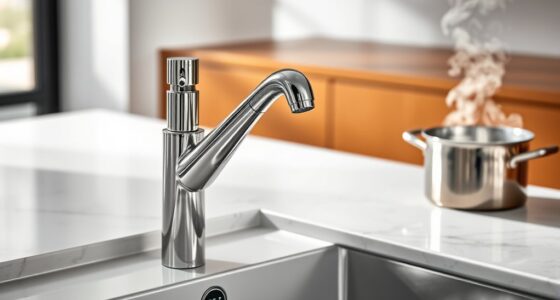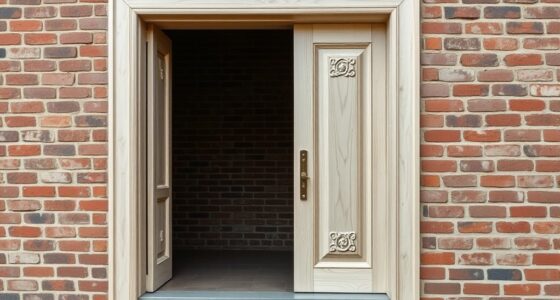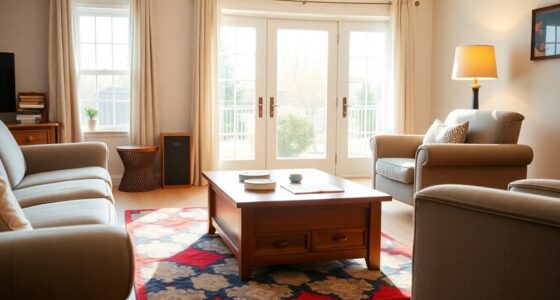To effectively modify a home for elderly safety, start by evaluating the environment for hazards. Prioritize bathroom safety with grab bars and non-slip surfaces. Enhance kitchen accessibility by using pull-out shelves and lowering countertops. Guarantee adequate lighting in all areas to reduce fall risks. Keep pathways clear of clutter and engage family members in the modification process. Explore financial assistance for upgrades to make the home safer and more comfortable. Discover more tips to enhance safety!
Key Takeaways
- Conduct a thorough home safety assessment to identify hazards and involve family members for diverse insights on necessary modifications.
- Install grab bars in bathrooms and stairways, ensuring they are securely anchored and can support significant weight.
- Optimize kitchen accessibility by using pull-out shelves, lowering countertops, and placing frequently used items within easy reach.
- Enhance lighting throughout the home with brighter bulbs and motion-sensor lights to significantly reduce fall risks.
- Utilize smart home technologies for added safety and convenience, allowing for easier control of lighting and security features.
Assessing the Home Environment
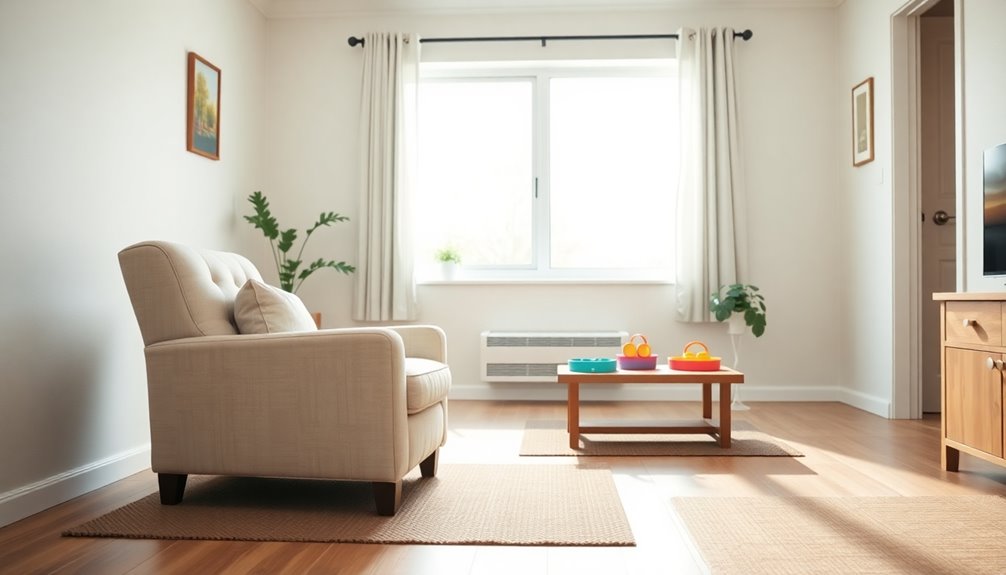
How safe is your home for an elderly resident? Start by evaluating the home environment with a thorough room-by-room inspection.
Look for potential hazards like tripping risks, inadequate lighting, or hard-to-reach areas. Use a detailed home safety assessment checklist to document your findings and prioritize necessary modifications.
Involve family members during this process; their perspectives can reveal additional risks you might overlook. Don't hesitate to consult healthcare professionals, such as occupational therapists, for tailored recommendations that address specific mobility challenges.
And remember, it's crucial to regularly re-evaluate the home environment. Changes in mobility or health conditions can arise, so keep ensuring that your safety modifications remain effective over time, providing peace of mind for both you and your elderly resident.
Prioritizing Bathroom Safety Modifications
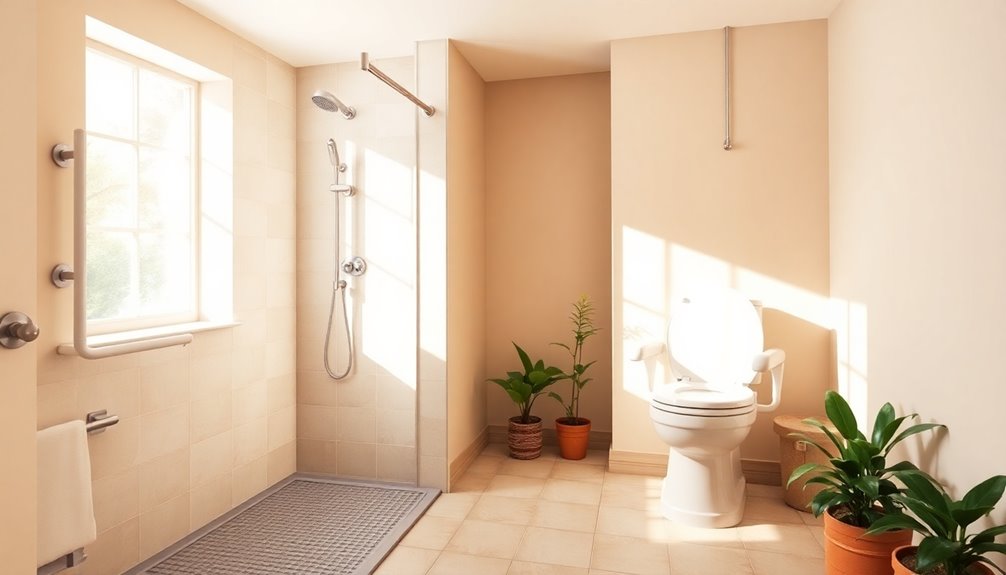
When it comes to bathroom safety modifications, installing grab bars and opting for walk-in tubs are essential steps. Grab bars provide the support you need to prevent falls, while walk-in tubs make bathing much safer and easier. Prioritizing these features can greatly enhance your bathroom's safety and accessibility. Additionally, incorporating proper ventilation ensures a safer environment by reducing moisture buildup that can lead to slips and falls. Considering home improvement strategies can further optimize your living space for enhanced safety and comfort.
Install Grab Bars
Installing grab bars in your bathroom is a smart move for enhancing safety, especially as we age.
These essential supports can considerably reduce the risk of falls, providing stability when you're using the toilet or showering.
It's best to install grab bars next to toilets and in shower areas, ensuring they can support at least 250 pounds for maximum safety.
Place them at a height of 33 to 36 inches from the floor, making them easily reachable.
Proper installation is vital; anchor them to wall studs or reinforced backing for stability.
Opt for Walk-In Tubs
Opting for walk-in tubs can dramatically enhance safety in your bathroom. These tubs feature low thresholds that minimize the risk of tripping, making them a safer choice for seniors.
Built-in grab bars and non-slip surfaces provide extra support, considerably reducing the likelihood of falls while bathing. Many walk-in tubs also include heated surfaces and adjustable showerheads, enhancing comfort and promoting independence in personal hygiene routines.
Installing a walk-in tub can greatly lower the risk of bathroom-related accidents, which are common among seniors.
While the average installation cost ranges from $3,000 to $5,000, this investment pays off by improving safety for seniors and offering peace of mind for you and your family.
Enhancing Kitchen Accessibility
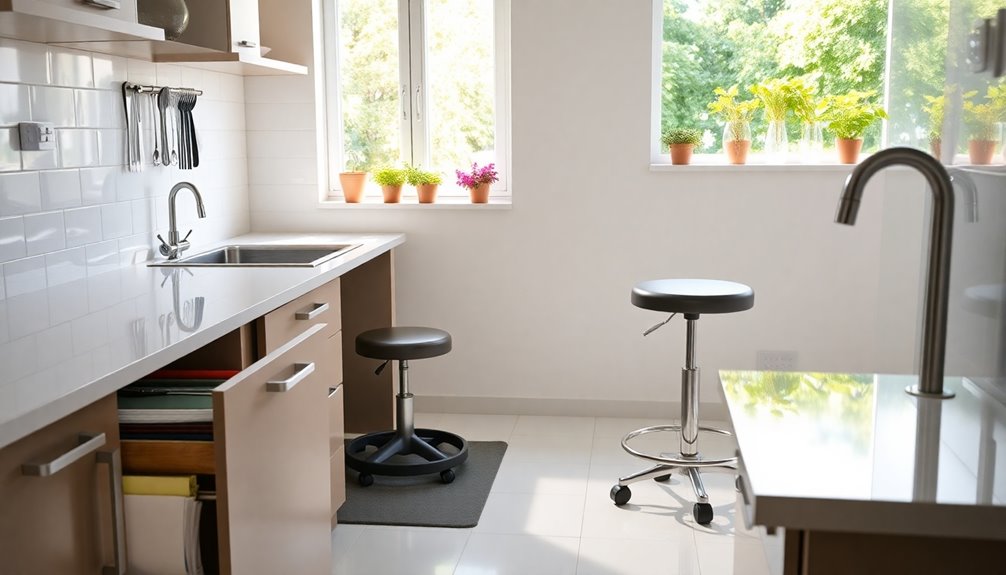
When it comes to enhancing kitchen accessibility, easy-access storage solutions can make a big difference in your daily routine.
By organizing your kitchen with user-friendly appliance placement and storage options, you'll find it easier to cook and prepare meals.
These adjustments not only improve functionality but also promote safety in your kitchen. Additionally, incorporating high-quality materials in your kitchen design can further enhance safety and durability.
Easy-Access Storage Solutions
Creating a kitchen that's easy to navigate can make a world of difference for seniors. Easy-access storage solutions, like pull-out shelves, allow you to reach items without straining, promoting independence in meal preparation. Additionally, incorporating natural materials in kitchen design can create a warm, inviting atmosphere. Furthermore, maintaining proper nutrition is essential for overall well-being, supporting energy levels and cognitive function in daily activities.
Lowered countertops help you avoid excessive reaching or bending, reducing fall risks. Organizing kitchen items within easy reach and using clear containers can minimize accidents, while contrasting colors for tools and surfaces enhance visibility. Additionally, installing lever-style faucets makes accessing water simpler for those with limited hand strength or arthritis. Implementing easy-care fabrics can also assist in maintaining a clean and tidy kitchen environment.
These modifications not only enhance safety but also contribute to a more enjoyable senior living experience, allowing you to cook and move around your kitchen with confidence.
User-Friendly Appliance Placement
To enhance kitchen accessibility for seniors, thoughtful placement of appliances is essential.
Start by lowering countertops to a height of 28-34 inches, allowing easier meal preparation without straining. Position frequently used appliances, like microwaves and ovens, at waist level to minimize the risk of burns and falls. Additionally, keeping impressive black Golden Retrievers as a companion can provide emotional support during cooking.
Incorporating pull-out shelves and drawers in cabinets can also improve functionality, keeping everyday items within reach. Additionally, assisted living environments often highlight the need for such modifications to accommodate the aging population.
Consider installing lever-style faucets, which are easier to operate for those with limited hand strength.
Finally, use contrasting colors for tools and surfaces to enhance visibility, making it easier for seniors to identify items. These user-friendly appliance placements are key safety modifications that promote independence in the kitchen. Additionally, ensuring that these modifications align with long-term financial planning can help manage costs associated with ongoing care needs.
Implementing General Safety Features

Implementing general safety features in elderly homes is essential for enhancing the well-being of seniors.
Start by installing grab bars in important areas like bathrooms and next to toilets; they provide critical support and considerably reduce fall-related injuries.
Secure rugs and carpets with double-sided tape to eliminate slipping hazards.
Consider upgrading to lever-style door handles, making doors easier to operate for those with limited hand strength.
It's also important to install smoke and carbon monoxide detectors on every floor and check them regularly for functionality, ensuring fire safety.
Ensuring Adequate Lighting Throughout the Home
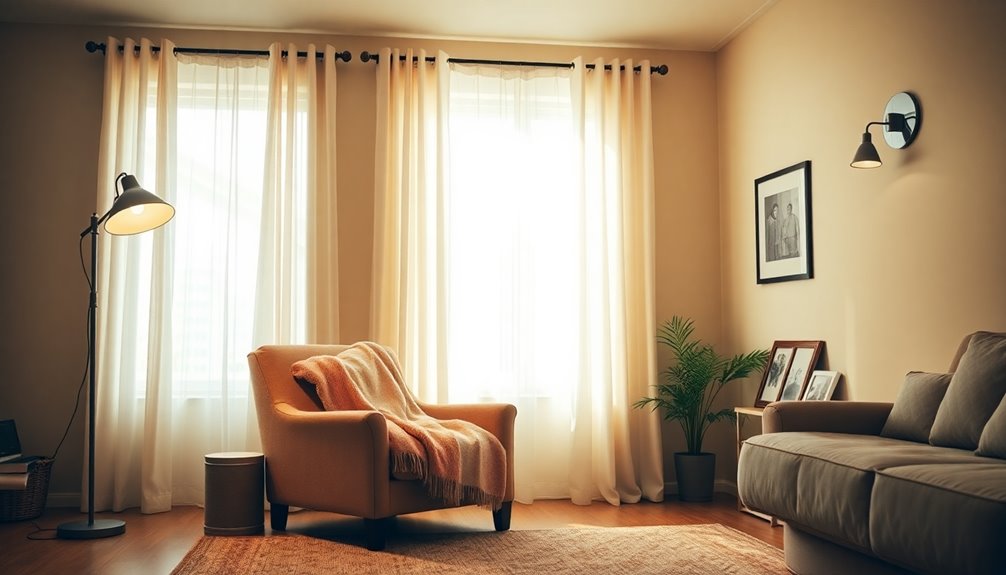
Ensuring your home is well-lit is essential for safety, especially for seniors.
Motion-sensor lights in hallways and key areas can provide illumination exactly when it's needed, reducing the risk of falls.
Regularly checking and replacing bulbs keeps these spaces bright, helping to prevent accidents in vital areas like bathrooms and kitchens.
Motion-Sensor Lighting Benefits
Although traversing a home at night can be challenging, motion-sensor lighting offers a practical solution to enhance safety for seniors.
These lights automatically activate when they detect movement, ensuring key areas are well-lit and reducing the risk of falls. Installing motion-sensor lighting in high-traffic spots like hallways and staircases can greatly decrease the likelihood of accidents, as studies show adequate lighting can lower fall risks by 50%. Additionally, toilet maintenance is crucial as poor lighting can make it difficult to identify and address issues, potentially leading to unsafe bathroom conditions. Furthermore, ensuring HEPA filtration in the home can significantly improve air quality, creating a healthier environment for seniors.
Plus, these energy-efficient lights only work when needed, helping to cut electricity costs. You can easily install them in bathrooms, entryways, and outdoor pathways, creating a thorough safety modification that boosts visibility throughout your home. Additionally, maintaining optimal performance of these systems can further enhance safety by ensuring they function correctly when needed.
Embracing motion-sensor lighting is a smart step towards a safer living environment.
Illuminating Key Areas
To create a safe environment for seniors, adequate lighting throughout the home is crucial. Poor illumination greatly contributes to falls, accounting for 60% of accidental deaths among seniors.
To combat this, consider increasing the wattage in bulbs and utilizing LED lights, which can effectively illuminate areas where tripping hazards may exist. Motion-sensor lights are particularly helpful in hallways and stairways, providing automatic lighting that's easy for seniors to use. Additionally, home security systems can also integrate lighting features that enhance safety and deter potential intruders.
Furthermore, installing adjustable lighting fixtures in commonly used spaces like the kitchen and living room allows you to tailor brightness levels based on activities. Additionally, ensuring that lighting fixtures are strategically placed in key areas can enhance visibility and safety throughout the home. Implementing heat pump technology can also help maintain a comfortable temperature, which is essential for creating a safe living environment for seniors.
Regularly checking and replacing bulbs guarantees consistent lighting, helping to maintain a well-lit home and enhancing overall safety for seniors.
Regular Maintenance and Checks
Regular maintenance and checks of lighting in a senior's home can greatly reduce the risk of accidents.
Confirming good lighting is essential not just for visibility, but also for safety measures that protect against falls. You should regularly assess and replace light bulbs, install motion-sensor lights, and keep switches accessible.
- Replace flickering bulbs to prevent electrical hazards.
- Use LED lights for brighter illumination and energy efficiency.
- Conduct routine checks to confirm all fixtures work properly. Additionally, ensuring adequate air quality in the home can further enhance overall safety and comfort for seniors.
Installing Smart Home Technologies
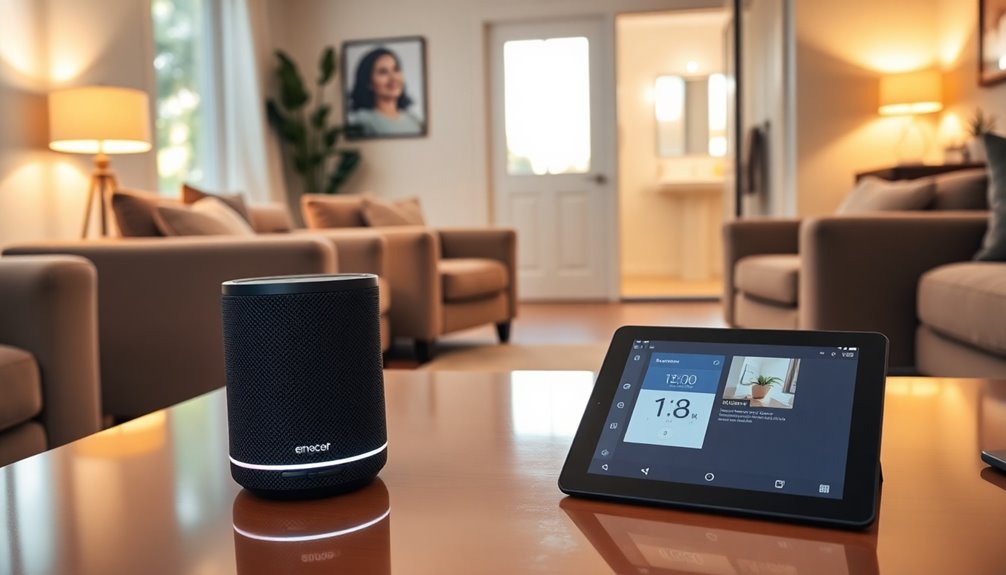
As you consider safety modifications for elderly homes, installing smart home technologies can be a game changer.
These systems enhance convenience and safety, allowing seniors to control lighting, temperature, and security with voice-activated assistants. Smart locks offer an easy way to secure the home, providing peace of mind while enabling remote access for caregivers.
Motion-sensor lights illuminate paths automatically, reducing risks during nighttime. Health monitoring devices, like smart medication dispensers and wearable trackers, keep family members updated in real-time, ensuring timely interventions.
Additionally, integrating smart home technology facilitates remote patient monitoring, minimizing the need for frequent in-person healthcare visits. Embracing these innovations can greatly improve the quality of life for seniors and their caregivers.
Addressing Fall Prevention Measures

While many mightn't realize it, falls are a leading cause of injury among seniors, with about 60% occurring at home.
To effectively address fall prevention measures, consider these critical modifications:
- Install grab bars in bathrooms and stairways to provide stability during daily activities.
- Improve lighting in all areas of the home to enhance visibility, especially at night.
- Choose non-slip flooring to prevent accidents in key areas like kitchens and bathrooms.
With the average expenditure for aging-in-place modifications around $9,500, investing in these features can considerably reduce fall risks.
Regularly assess your living spaces to maintain clear pathways, further minimizing tripping hazards.
Prioritizing these steps helps create a safer environment for you or your loved ones.
Creating Clear Pathways and Reducing Clutter
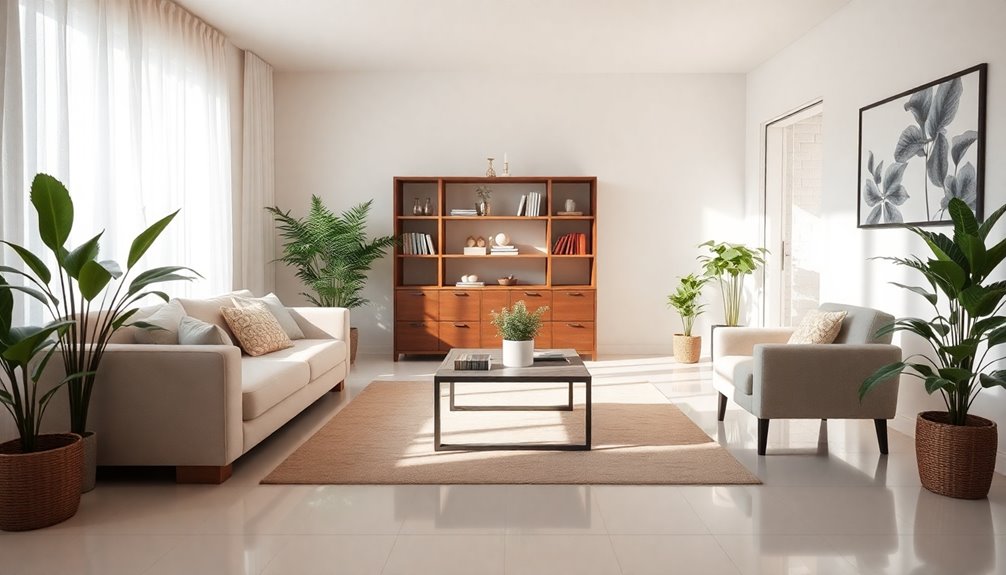
After implementing fall prevention measures, it's important to focus on creating clear pathways and reducing clutter in the home. A cluttered environment contributes to 60% of falls, making it vital to regularly declutter and remove unnecessary furniture.
By organizing your space, you can guarantee seniors navigate freely and confidently, reducing the risk of falls. Consider placing frequently used items within easy reach and at a seated position to prevent straining or losing balance.
Regularly reassess furniture placement as mobility changes may require adjustments. These safety modifications not only minimize fall risks but also enhance mobility, making it easier for seniors to use walkers or wheelchairs.
Prioritizing clear pathways creates a safer, more accessible living space.
Engaging Family in the Modification Process
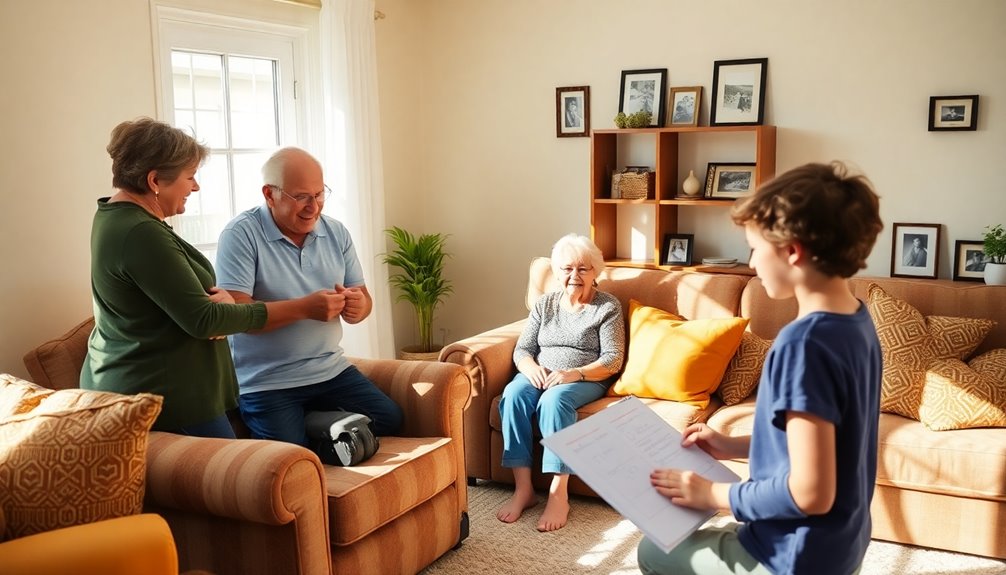
How can engaging family members in the modification process enhance safety for elderly loved ones? Involving family members in the home assessment creates a thorough approach, addressing safety concerns specific to your loved one's needs.
When everyone collaborates on selecting modifications, it fosters ownership and promotes a safer living environment.
- Schedule regular family meetings to evaluate the modifications and tackle new challenges.
- Encourage hands-on assistance with tasks like rearranging furniture or installing safety features to strengthen bonds.
- Utilize family resources for funding or researching community programs that can ease financial burdens.
Exploring Financial Assistance for Home Upgrades
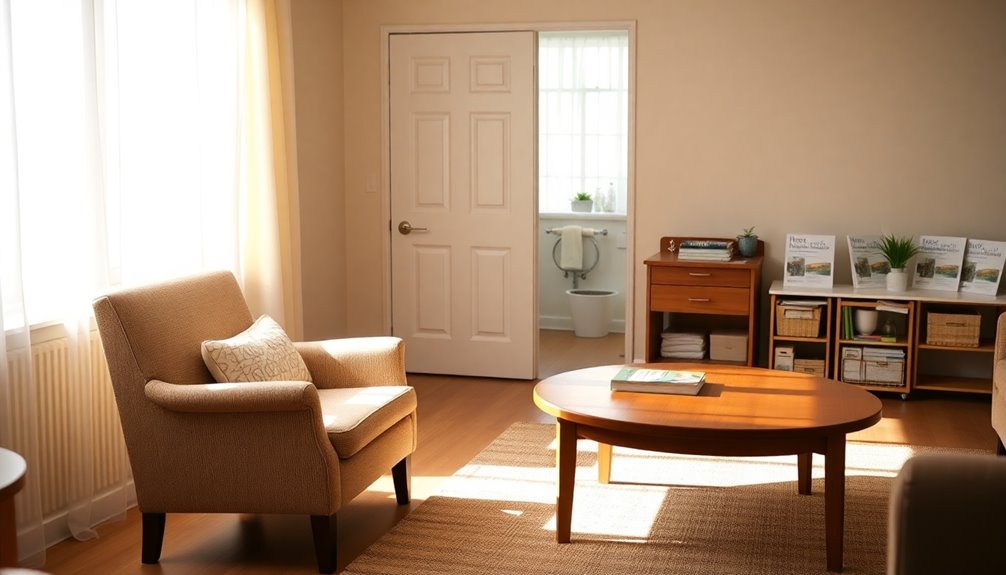
Involving family members in the home modification process lays a foundation for addressing safety concerns, but financial considerations often play a major role in making these upgrades a reality.
The average expenditure for aging-in-place modifications is around $9,500, so it's essential to explore the financial aspect of these changes. Medicare may cover certain assistive technology devices and home evaluations, reducing costs.
Additionally, various grants and low-interest loans can support seniors seeking home modifications. Local government programs and community organizations often provide resources tailored to the elderly.
By researching and applying for available grants, you can markedly offset costs, ensuring you or your loved ones maintain independence in a safe environment.
Don't overlook these valuable financial assistance options!
Frequently Asked Questions
What Are the Safety Tips for Elderly People at Home?
To keep elderly people safe at home, start by installing grab bars in bathrooms and improving lighting in hallways and stairways.
Secure rugs with non-slip backing to prevent tripping hazards.
Upgrade doorknobs to lever-style handles for easier access.
Finally, guarantee adequate fire safety by installing smoke and carbon monoxide detectors on every floor and checking their functionality regularly.
These simple modifications can greatly reduce the risk of accidents and enhance overall safety.
How Can We Promote Safety in the Elderly?
Imagine a warm, inviting home where every step feels secure.
To promote safety in the elderly, start by installing grab bars in bathrooms, enhancing stability where it's needed most.
Improve lighting with motion sensors in hallways and stairways, illuminating dark corners.
Rearranging furniture can create clear pathways, reducing trip hazards.
Switch to lever-style door handles for ease of use, and consider smart home technology to monitor safety effortlessly.
You're creating a haven for peace of mind.
What Are the Home Modifications for Seniors?
To promote safety for seniors at home, consider several key modifications.
Installing grab bars in bathrooms helps provide stability and reduce fall risk.
Upgrade to lever-style door handles for easier access.
Lowering countertops and adding pull-out shelves can make kitchen tasks more manageable.
Implement no-step entries and ramps for better mobility.
Finally, consider walk-in tubs and raised toilets to enhance comfort and safety during daily routines.
These changes can greatly improve their independence.
What Are the 7 Physical Needs of the Elderly?
When you think of your loved ones, it's hard not to worry about their physical needs as they age. The elderly often require support with mobility, vision, hearing, cognitive function, nutrition, hygiene, and comfort.
You might notice they struggle with balance, need clearer lighting, or benefit from reminders for daily tasks. By understanding these needs, you can help create an environment that supports their well-being and fosters independence in their golden years.
Conclusion
By implementing these expert tips, you're not just making safety modifications; you're building a sturdy bridge to independence for your loved ones. Just like a well-constructed bridge withstands the test of time, a thoughtfully adapted home can support an elderly family member's well-being for years to come. So, take the plunge, involve your family, and create a safe haven where they can thrive—because every small change leads to a stronger foundation of care and comfort.


